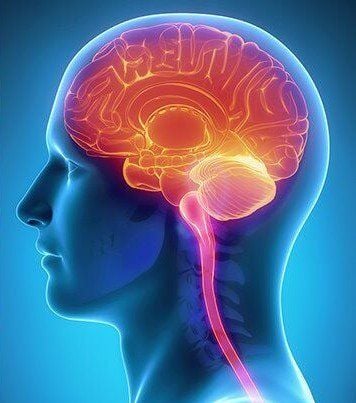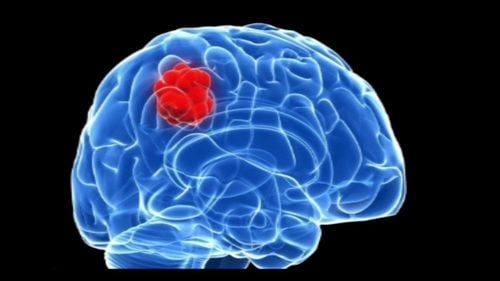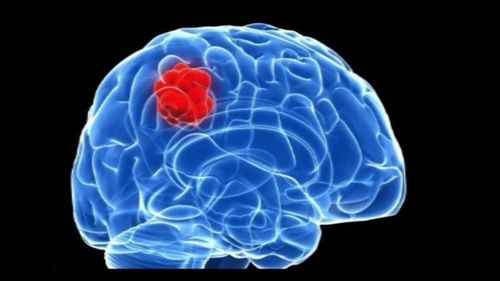This is an automatically translated article.
Brain tumors form due to the abnormal growth of cells in the brain. The growth rate and location of the brain tumor will determine the patient's neurological function.
1. How do brain tumors form?
Brain tumors form when cells in the brain grow out of control. Some brain tumors are not cancerous (benign brain tumors) and some brain tumors are cancerous (malignant brain tumors). The growth rate as well as the location of the brain tumor determines the patient's nervous system function. Brain tumors can start in the brain (primary brain tumors) or can start in other parts of the body and spread to the brain.
There are many types of primary brain tumors and are named based on the type of cell in which they start. Brain tumors that metastasize from another part of the body are called metastatic cancers. For example, lung cancer that has spread to the brain is still lung cancer, and the tumor cells when viewed under the microscope will look like lung cancer cells. Brain tumors are classified by the World Health Organization according to tumor grade and histology (the appearance of cells under the microscope). The levels are numbered from I to IV, where I is the least dangerous and IV is the most dangerous.
2. What are the risk factors for brain tumors?
Risk factors for brain tumor formation include radiation exposure, disease treatment or exposure to atomic bombs, and certain genetic disorders, including neurofibromas types 1 and 2 , von Hippel-Lindau disease and tuberous sclerosis. There are currently no guidelines for screening for brain tumors, but people with genetic disorders that predispose them to brain tumors may be offered imaging tests when needed.
3. Symptoms of brain tumor
Initially, a brain tumor may not have any symptoms. As a brain tumor grows in size, it can cause symptoms depending on where the tumor is in the brain. The tumor puts pressure on the surrounding tissues, causing symptoms including:
Headaches, seizures, memory loss, personality changes; Problems with thinking, thinking processing; Nausea, vomiting, loss of appetite; Weakness, difficulty walking, or problems with balance; Speech and language disorders.
4. How is a brain tumor diagnosed?
When your doctor suspects you have a brain tumor, they will order tests that include:
Neurological exam: A neurological exam may include testing for vision, hearing, balance, ability coordination, strength and reflexes. Imaging tests. Magnetic resonance imaging (MRI) is commonly used to diagnose brain tumors. Several specialized MRI techniques — including functional MRI, perfusion MRI, and magnetic resonance spectroscopy — can help doctors evaluate tumors and develop treatment plans. Sometimes other imaging tests are recommended in certain cases, including computed tomography (CT) and positron emission tomography (PET). Biopsy: A biopsy may be done as part of the surgical procedure to remove the brain tumor or just a needle biopsy. Needle biopsies can be done for brain tumors in hard-to-reach areas or very sensitive areas of the brain that could be damaged by a surgery. The doctor will drill a small hole in the patient's skull. Then, insert a thin needle through the hole and remove a small portion of the tumor. The biopsy sample will be viewed under a microscope to determine if it is a malignant or benign brain tumor.
5. How is a brain tumor treated?
Treatment for a brain tumor depends on the type, size and location of the tumor as well as the patient's overall health. Here are some treatments for brain tumors:
5.1. Surgery for brain tumors Surgery is usually the first line of treatment used unless the tumor is located in a location that is not safe for surgery. If the brain tumor is in an operable location, the surgeon will try to remove as much of the brain tumor as possible. Some brain tumors are small and easily separate from surrounding brain tissue, and surgery can completely remove the tumor. Some brain tumors cannot separate from surrounding tissue or are located near sensitive areas in the brain, making surgery risky. While it is not possible to remove all of the tumor, removing part of it can help relieve symptoms of the disease.
Surgical removal of a brain tumor carries risks, such as infection and bleeding. Other risks may depend on the part of the brain where the tumor is located. For example, tumors located near the optic nerve can lead to a risk of vision loss.
5.2. Radiation therapy for brain tumors Radiation therapy uses high-energy beams, such as X-rays or protons, to kill cancer cells. Radiation therapy can come from a machine outside your body or radiation placed inside the body close to the brain tumor. Radiation from the outside can be focused only on the area of the brain where the tumor is located or it is applied to the entire brain. Whole brain radiation is often used to treat cancer that has spread to the brain from some other part of the body and formed multiple tumors in the brain.
There is now a newer form of radiation therapy than proton beam therapy. This method allows the doctor to control the radiation more precisely. It may be useful to treat brain tumors in children and tumors that are very close to sensitive areas of the brain. Proton beam therapy is not as widely available as traditional X-ray radiation therapy. The side effects of radiation therapy will depend on the type and dose of radiation. Common side effects during or shortly after radiation therapy include fatigue, headache, memory loss, scalp irritation, and hair loss.
5.3. Chemotherapy for brain tumors Chemotherapy is the use of drugs to kill cancer cells. Chemotherapy drugs can be taken by mouth or injected into a vein. The chemotherapy drug commonly used to treat brain tumors is Temozolomide (Temodar). Other chemotherapy drugs may be recommended depending on the type of cancer. Side effects of chemotherapy depend on the type and dose of the drug, and include nausea, vomiting, and hair loss.
5.4. Targeted drug therapy Targeted drug treatments focus on specific abnormalities present in cancer cells. By blocking tumor abnormalities, targeted drug treatments can kill cancer cells. Targeted therapeutic drugs are available for several types of brain tumors that are being studied in clinical trials. Your doctor may test tumor cells to see if targeted therapy is an effective treatment for your brain tumor.
In short, brain tumor is an extremely dangerous disease. Tumors can compress and affect other areas of the brain, thereby seriously affecting the patient's neurological function. When experiencing unusual symptoms such as headache, memory impairment, convulsions, difficulty in movement and language, patients should quickly seek medical attention at medical facilities.
Please dial HOTLINE for more information or register for an appointment HERE. Download MyVinmec app to make appointments faster and to manage your bookings easily.
References: oncolink.org, mayoclinic.org












